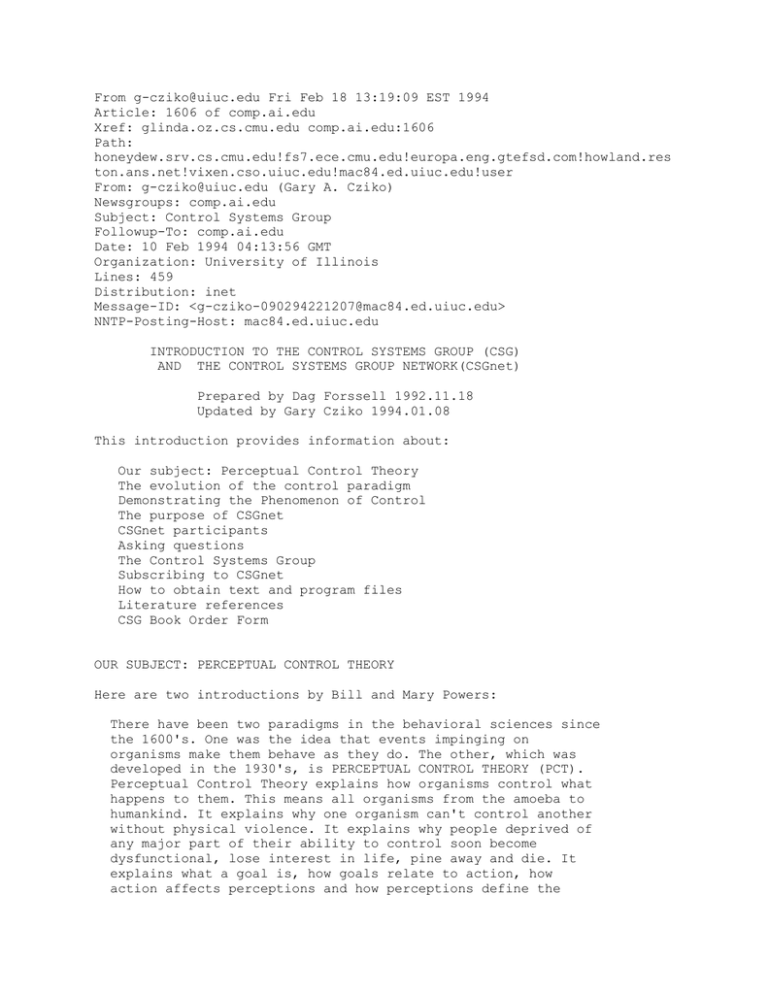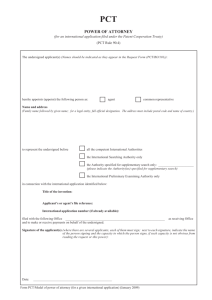From Fri Feb 18 13:19:09 EST 1994 Xref: glinda.oz.cs.cmu.edu comp.ai.edu:1606
advertisement

From g-cziko@uiuc.edu Fri Feb 18 13:19:09 EST 1994 Article: 1606 of comp.ai.edu Xref: glinda.oz.cs.cmu.edu comp.ai.edu:1606 Path: honeydew.srv.cs.cmu.edu!fs7.ece.cmu.edu!europa.eng.gtefsd.com!howland.res ton.ans.net!vixen.cso.uiuc.edu!mac84.ed.uiuc.edu!user From: g-cziko@uiuc.edu (Gary A. Cziko) Newsgroups: comp.ai.edu Subject: Control Systems Group Followup-To: comp.ai.edu Date: 10 Feb 1994 04:13:56 GMT Organization: University of Illinois Lines: 459 Distribution: inet Message-ID: <g-cziko-090294221207@mac84.ed.uiuc.edu> NNTP-Posting-Host: mac84.ed.uiuc.edu INTRODUCTION TO THE CONTROL SYSTEMS GROUP (CSG) AND THE CONTROL SYSTEMS GROUP NETWORK(CSGnet) Prepared by Dag Forssell 1992.11.18 Updated by Gary Cziko 1994.01.08 This introduction provides information about: Our subject: Perceptual Control Theory The evolution of the control paradigm Demonstrating the Phenomenon of Control The purpose of CSGnet CSGnet participants Asking questions The Control Systems Group Subscribing to CSGnet How to obtain text and program files Literature references CSG Book Order Form OUR SUBJECT: PERCEPTUAL CONTROL THEORY Here are two introductions by Bill and Mary Powers: There have been two paradigms in the behavioral sciences since the 1600's. One was the idea that events impinging on organisms make them behave as they do. The other, which was developed in the 1930's, is PERCEPTUAL CONTROL THEORY (PCT). Perceptual Control Theory explains how organisms control what happens to them. This means all organisms from the amoeba to humankind. It explains why one organism can't control another without physical violence. It explains why people deprived of any major part of their ability to control soon become dysfunctional, lose interest in life, pine away and die. It explains what a goal is, how goals relate to action, how action affects perceptions and how perceptions define the reality in Perceptual can handle concept of which we live and move and have our being. Control Theory is the first scientific theory that all these phenomena within a single, testable how living systems work. William T. Powers, November 3, 1991 PERCEPTUAL CONTROL THEORY While the existence of control mechanisms and processes (such as feedback) in living systems is generally recognized, the implications of control organization go far beyond what is generally accepted. We believe that a fundamental characteristic of organisms is their ability to control; that they are, in fact, living control systems. To distinguish this approach from others using some version of control theory but forcing it to fit conventional approaches, we call ours Perceptual Control Theory, or PCT. PCT requires a major shift in thinking from the traditional approach: that what is controlled is not behavior, but perception. Modelling behavior as a dependent variable, as a response to stimuli, provides no explanation for the phenomenon of achieving consistent ends through varying means, and requires an extensive use of statistics to achieve modest (to the point of meaningless) correlations. Attempts to model behavior as planned and computed output can be demonstrated to require levels of precise calculation that are unobtainable in a physical system, and impossible in a real environment that is changing from one moment to the next. The PCT model views behavior as the means by which a perceived state of affairs is brought to and maintained at a reference state. This approach provides a physically plausible explanation for the consistency of outcomes and the variability of means. The PCT model has been used to simulate phenomena as diverse as bacterial chemotaxis, tracking a target, and behavior in crowds. In its elaborated form, a hierarchy of perceptual control systems (HPCT), it has lent itself to a computer simulation of tracking, including learning to track, and to new approaches to education, management, and psychotherapy. Control systems are not new in the life sciences. However, numerous misapprehensions exist, passed down from what was learned about control theory by non-engineers 40 or 50 years ago without further reference to newer developments or correction of initial misunderstandings. References in the literature to the desirability of positive feedback and the assertion that systems with feedback are slower than S-R systems are simply false, and concerns about stability are unfounded. The primary barrier to the adoption of PCT concepts is the belief - or hope - that control theory can simply be absorbed into the mainstream life sciences without disturbing the status quo. It is very hard to believe that one's training and life work, and that of one's mentors, and their mentors, must be fundamentally revised. Therefore, PCT appeals to those who feel some dissatisfaction with the status quo, or who are attracted to the idea of a generative model with broad application throughout the life sciences (plus AI and robotics). There are very few people working in PCT research. Much of its promise is still simply promise, and it meets resistance from all sides. It is frustrating but also tremendously exciting to be a part of the group who believe that they are participating in the birth of a true science of life. Mary Powers, November 1992 THE EVOLUTION OF THE CONTROL PARADIGM The PCT paradigm originates in 1927, when an engineer named Harold Black recognized and clearly described a closed loop control system as a special kind of mechanism. He was working with the negative feedback amplifier, which is a control device. This led to a new engineering discipline and the development of many purposeful machines. Purposeful machines have built-in intent to achieve consistent ends by variable means under changing conditions. The discovery and formalization of the phenomenon of control is the first alternative to the cause-effect perspective ever proposed in any science. The first discussion of purposeful machines and people came in 1943 in a paper called: Behavior, Purpose and Teleology by Rosenblueth, Wiener and Bigelow. This paper also argued that purpose belongs in science as a real phenomenon in the present. Purpose does not mean that somehow the future influences the present. The first specific suggestion on how to use the concept of control to understand people came in 1957 in a paper entitled: A General Feedback Theory of Human Behavior by McFarland, Powers and Clark. In 1973 William T. (Bill) Powers published a seminal book called "Behavior: the Control of Perception," which still is the major reference for PCT. See literature below. This book spells out a complete model of how the human brain and nervous system works like a living perceptual control system. Our brain can be viewed as a system that controls its own perceptions. This view suggests explanations for many previously mysterious aspects of how people interact with their world. Perceptual Control Theory has been accepted by independently thinking psychologists, scientists and other interested people. The result is that an association has been formed (the Control System Group), several books published, this CSGnet set up and that at latest count 16 professors are teaching PCT in American universities today. DEMONSTRATING THE PHENOMENON OF CONTROL The phenomenon of control is largely unrecognized in science today. It is not well understood in important aspects even by many control engineers. Yet the phenomenon of control, when it is recognized and understood, provides a powerful enhancement to scientific perspectives. It is essential to recognize that this phenomenon exists and deserves an explanation before any of the discourse on CSGnet will make sense. Please download the introductory demonstration dem1a.exe, which is an interactive program and/or rubberbd.txt, which is a text telling you how to demonstrate the phenomenon to yourself and a friend using only two rubber bands. THE PURPOSE OF CSGnet: CSGnet provides a forum for development, use and testing of PCT. CSGnet PARTICIPANTS Many interests and backgrounds are represented here. Psychology, Sociology, Linguistics, Artificial Intelligence, Robotics, Social Work, Neurology, Modeling and Testing. All are represented and discussed. As of May 1993 there were about 140 individuals from 19 countries subscribed to CSGnet. ASKING QUESTIONS Please introduce yourself with a statement of your professional interests and background. It will help someone answer if you spell out which demonstrations, introductory papers and references you have taken the time to digest. THE CONTROL SYSTEMS GROUP The CSG is an organization of people in the behavioral, social, and life sciences who see the potential in PCT for increased understanding in their own fields and for the unification of diverse and fragmented specialties. Annual dues are $45 for full members and $5 for students (subsidized). The tenth North American annual meeting of the CSG will held in Durango, Colorado, on the campus of Fort Lewis College. It will be held 27-31 July 1994. There will be 7 plenary meetings (mornings and evenings), with afternoons, mealtimes, and late night free for further discussion or recreation. Full details will be available on CSGnet or by mail after April 1, 1994. The first meeting of the European Control Systems Group (ECSG) will be held on 22-26 June 1994, in Aberystwyth, Wales, UK. Further information can be obtained from Marcos Rodrigues <mar@aber.ac.uk>. Net subscribers find it useful to have thematic collections of some of the network discussions, and it enables non-net members to keep up with them. Threads from this net are published on a quarterly basis in a booklet called the Closed Loop. These booklets, distributed to members, are available separately. A complimentary copy of Closed Loop will be sent upon request. Back issues are available: Volume 1 (4 issues) is $12. Single issues of Volume 2, beginning with Jan. 1992, are $6 each. For membership information and back issues of Closed Loop, write: CSG, c/o Mary Powers, 73 Ridge Place CR 510, Durango, CO 81301-8136. SUBSCRIBING TO CSGnet When you subscribe to CSGnet, you get this message, CSGINTRO.DOC. But you may have received it from a friend who printed it, seen it on a demodisk, or seen it on Usenet. To subscribe, send a message as follows: (Internet address followed by two message commands, one per line) LISTSERV@VMD.CSO.UIUC.EDU Subscribe CSG-L Lastname, Firstname, Affiliation, City, State. help (Lastname, Firstname, etc is optional commentary, but helpful). ("help" requests a list of most commonly used commands). (The Bitnet address is: LISTSERV@UIUCVMD). (This server is not sensitive to upper or lower case letters). CSGnet can also be accessed via Usenet (NetNews) where it is listed as the newsgroup bit.listserv.csg-l. For more information about accessing CSGnet, contact Gary Cziko, the network manager, at G-CZIKO@UIUC.EDU HOW TO OBTAIN TEXT AND PROGRAM FILES A number of ASCII documents and binary computer programs are available on a fileserver maintained by Bill Silvert. It is possible to download all these files via e-mail. If you are on internet, it is easiest to obtain binary program files via anonymous FTP. If you are on MCI mail, you have read about how you can transfer binary files with Kermit or Zmodem protocols. (Type help at the MCI mail prompt for directions). But the server cannot send binary files over the internet mail network, so download uue.scr first, then request the binary files uuencoded as ASCII files. The Internet address for the server is BIOME.BIO.NS.CA. CSGnet files are kept in the subdirectory pub/csg. To get basic information and a current listing of available documents, send a message as follows: (Internet) To: SERVER@BIOME.BIO.NS.CA Commands: help ftp get csg/Index end "help" "ftp" "get csg/Index" requests commands and explanations. asks details on anonymous FTP for internet. requests the Index for the csg subdirectory. Pay attention to letter case for commands! DOS is not dos. As part of the index (of the csg directory), you may be looking at: programs/msdos: dem1a.exe 128437 dem2a.exe 123649 Bill Power's demonstr of perceptual control Bill Power's modelling of control documents/forssell: uud.scr 53406 ASCII Compile uud.exe w DOS debug Dir @ end. If you want dem1a.exe (uuencoded) to get a "live" demonstration of the phenomenon of control, and the ASCII file uud.scr with directions at the end on how to use DOS debug to compile uud.exe to decode it, send the following message commands: uue csg/programs/msdos/dem1a.exe get csg/programs/forssell/uud.scr The uuencoded dem1a.exe will be sent in four parts. Remove headers and use an editor to make it into one file (starting with table and ending with end) before you use uud.exe to restore the file. dem1a.exe is a self-extracting archive file. Put it in it's own directory before you execute it. You get complete documentation and a running program. REFERENCES Here are some selected books, papers and computer programs on Perceptual Control Theory (entries preceded by an asterisk are available from The Control Systems Group, 460 Black Lick Road, Gravel Switch, KY 40328. See order form below). For a complete list of CSG-related publications, get the file biblio.pct from the fileserver as described above. Entries preceded by an asterisk in the partial list shown here are available from: The Control Systems Group, 460 Black Lick Road, Gravel Switch, KY 40328. Price shown includes mailing by surface worldwide. Forssell, Dag C., (1993). Perceptual Control: A Key Management Insight." In ENGINEERING MANAGEMENT JOURNAL, 5(4), 17-25. Introduction to PCT as an answer to leadership issues. Forssell, Dag C. (Ed.), (1994). PERCEPTUAL CONTROL THEORY: DOS COMPUTER DEMONSTRATIN, TUTORIALS, SIMULATIONS, EXPLANATIONS. Dag Forssell, Purposeful Leadership, 23903 Via Flamenco, Valencia, CA, USA: Available on 1.44 MB 3 1/2 inch disk (1 ea) or 1.2 MB 5 1/4 inch disk (2 ea). May be copied freely. $10 U.S. postpaid by air world wide. Powers, William T. (1973). BEHAVIOR: THE CONTROL OF PERCEPTION. Hawthorne, NY: Aldine DeGruyter. The basic text. Petrie, Hugh G. (1981). THE DILEMMA OF INQUIRY AND LEARNING. Chicago: University of Chicago Press. Ford, Edward E. (1989). FREEDOM FROM STRESS. Scottsdale AZ: Brandt Publishing. A self-help book. PCT in a counseling framework. Hershberger, Wayne. (Ed.). (1989). VOLITIONAL ACTION: CONATION AND CONTROL (Advances in Psychology No. 62). NY: North-Holland. 25 articles (not all PCT) *Powers, William T. (1989). LIVING CONTROL SYSTEMS: SELECTED PAPERS. Gravel Switch, KY: CSG Books. ($16.50 postpaid) Previously published papers, 1960-1988. Gibbons, Hugh. (1990). THE DEATH OF JEFFREY STAPLETON: EXPLORING THE WAY LAWYERS THINK. Concord, NH: Franklin Pierce Law Center. A text for law students using control theory. Marken, Richard S. (Ed.). (1990). Purposeful Behavior: The control theory approach. AMERICAN BEHAVIORAL SCIENTIST, 34(1). (Thousand Oaks, CA: Sage Publications) 11 articles on control theory. McPhail, Clark. (1990). THE MYTH OF THE MADDING CROWD. New York: Aldine de Gruyter. Introduces control theory to explain group behavior. *Robertson, Richard J. and Powers, William T. (Eds.). (1990). INTRODUCTION TO MODERN PSYCHOLOGY: THE CONTROL THEORY VIEW. Gravel Switch, KY: CSG Book. ($25 postpaid) College-level text. Runkel, Philip J. (1990). CASTING NETS AND TESTING SPECIMENS. New York: Praeger. When statistics are appropriate; when models are required. Richardson, George P. (1991). FEEDBACK THOUGHT IN SOCIAL SCIENCE AND SYSTEMS THEORY. Philadelphia: University of Pennsylvania Press. A review of systems thinking, including PCT. *Marken, Richard S. (1992). MIND READINGS: EXPERIMENTAL STUDIES OF PURPOSE. Gravel Switch, KY: CSG Books. ($18 postpaid) Research papers exploring control. McClelland, Kent. (In press). Perceptual Control and Social Power. SOCIOLOGICAL PERSPECTIVES. McPhail, Clark., Powers, William T., & Tucker, Charles W. (1992). Simulating individual and collective action In temporary gatherings. SOCIAL SCIENCE COMPUTER REVIEW, 10(1), 1-28. Computer simulation of control systems in groups. Cziko, Gary A. (1992). Purposeful behavior as the control of perception: Implications for educational research. EDUCATIONAL RESEARCHER, 21(9), 10-18, 27. (and...) Introduction to PCT and implications for educational research. Cziko, Gary A. (1992). Perceptual control theory: One threat to educational research not (yet?) faced by Amundson, Serlin, and Lehrer. EDUCATIONAL RESEARCHER, 21(9), 25-27. Response to critics of previous article. *Powers, William T. (1992). LIVING CONTROL SYSTEMS II: SELECTED PAPERS. Gravel Switch, KY: CSG Books. ($22 postpaid) Previously unpublished papers, 1959-1990 Forssell, Dag C., (1993). Perceptual Control: A Key Management Insight." In ENGINEERING MANAGEMENT JOURNAL, 5(4), 17-25. Introduction to PCT as an answer to leadership issues. Forssell, Dag C. (Ed.), (1994). PERCEPTUAL CONTROL THEORY: DOS COMPUTER DEMONSTRATIN, TUTORIALS, SIMULATIONS, EXPLANATIONS. Dag Forssell, Purposeful Leadership, 23903 Via Flamenco, Valencia, CA, USA: 1.44 MB 3 1/2 inch disk (1 ea) or 1.2 MB 5 1/4 inch disk (2 ea). May be freely copied $10 U.S. by air world wide. Write: Purposeful Leadership, 23903 Via Flamenco, Valencia, CA, USA =========================================================== CSG BOOK ORDER FORM (from Greg Williams, CSG Book Publishing) After so many mentions of CSG books on CSGnet, I should make it easy for all of you folks to order them. Just send the following with your check or money order (U.S. funds ONLY). All prices are postpaid via book post (send extra if you want books fast). If you order five or more books (mixed or matched), you can take off a 20% discount, but I will bill you for actual shipping. ----------------------------------------------------------------TO: CSG Book Publishing 460 Black Lick Rd. Gravel Switch, KY 40328 PLEASE SEND THE FOLLOWING: _____ copies of LIVING CONTROL SYSTEMS @ $16.50 _____ copies of LIVING CONTROL SYSTEMS II @ $22.00 _____ copies of INTRODUCTION TO MODERN PSYCHOLOGY @ $25.00 _____ copies of MIND READINGS @ $18.00 NAME _________________________________________________________ ADDRESS ______________________________________________________ _______________________________________________________________ _______________________________________________________________ _______________________________________________________________





